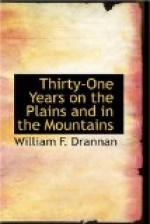Just at sunrise we made our appearance at the Lieutenant’s quarters, and he informed us that the Indians had made an attack on the settlement on the east side of the San Antonio desert; had killed two families, taken two little girls prisoner and captured a lot of stock from the settlers.
This report had first reached Gen. Crook at Fort Yuma, and he had dispatched the news to Lieut. Jackson. This being a strange country to the Lieutenant, having never been over it and knowing that I had been through it twice, once with Uncle Kit Carson and another time in company with Jim Beckwith, he insisted on my going out in that section to investigate the matter and see whether or not the report was true.
The day following George and I started with four assistants for the settlement. Each of us took two saddle horses and one pack animal for each two men, with ten days’ rations. From there to the settlement was about seventy-five miles.
Knowing just where the majority of the Apache force was concentrated, we took rather a circuitous route in-stead of going direct to the settlement in order to ascertain whether the depredations were committed by Apaches or Pimas.
The fifth day out we struck the settlement, but did not cross the Indian trail, which led me to think that the work was done by Pimas and not Apaches.
When we arrived there no one could tell us how many Indians there were nor what they looked like, but when I came to find out the truth of the matter there had been no families massacred, nor had the two girls been taken prisoners, but there had been two boys killed that were herding stock.
We remained there one day in order to learn what we could in regard to the trouble and then struck the trail of the Indians and followed it two days, but it was so old that we gave it up, as it was then twelve days since the depredations were committed and we knew that the Indians were a long ways off by that time. We took a different route on our return, and the second day we saw a small band of Indians traveling toward the settlement, which we had left four days previous. We started in pursuit of them and struck their trail before it was dark. I was confident that they would camp at the first water they came to, which was about seven or eight miles from there, so we staked our horses out on good grass, sat down and ate our lunch while we waited for the clear moon to make its appearance and light us across the country where we might find the noble red men of the plains and entertain them for a while at least. We thought that it would take us about all night to track them up by the light of the moon, find their camp and play them just one little tune of “How came you so?”
About ten o’clock the moon arose, but we waited until it was two hours high, giving our horses a chance to fill up, after which we mounted and took the trail of the Pimas, which we had not great trouble in finding.




